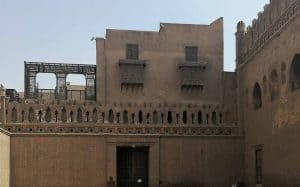The Symbolism and Meaning of the Dara Knot

Updated On: April 28, 2024 by Maha Yassin
For centuries, Celtic knots have captivated and inspired with their intricate designs and timeless beauty. These interwoven patterns, often found adorning ancient stonework, manuscripts, and jewellery, transcend mere decoration. Each knot carries a wealth of symbolism, reflecting the values and beliefs of the Celtic people. The Dara knot stands out among these powerful emblems for its unique design and profound meaning.
Imagine intricate loops and braids endlessly intertwined, forming a mesmerising design. This is the essence of Celtic knots, a hallmark of ancient Celtic art. Far more than mere decoration, these knots served as a visual language, conveying a wealth of symbolism and meaning. Each twist and turn held a story, reflecting the Celts’ deep connection to nature, reverence for the unseen world, and core values. Among these captivating symbols, the Dara knot stands out for its unique form and the depth of meaning within its interwoven lines. Let’s embark on a journey to unveil the mysteries of the Dara knot, exploring its origins, the rich tapestry of symbolism it embodies, and its lasting impact on Celtic culture.
Origin and Etymology: Unveiling the Mysteries of the Dara Knot
The Dara knot’s exact origins remain in mystery, much like the intricate network of roots that the symbol depicts. Unlike other Celtic knots with clear archaeological evidence, the Dara knot’s timeline is less certain. However, by delving into its name and exploring some intriguing possibilities, we can begin to piece together the story of this powerful symbol.
Shrouded in Time: The Limited Archaeological Evidence
Unlike some of its more prominent counterparts within Celtic knots, the Dara knot seems to have a more elusive past. While archaeological finds reveal a rich tapestry of Celtic knotwork adorning artefacts and monuments from the early centuries AD, the Dara knot appears less frequently documented. This lack of concrete evidence from the Celtic period makes pinpointing its origin challenging. Some scholars speculate that the Dara knot might have emerged sometime during the late Roman period (around the 3rd-4th centuries AD), but definitive proof remains elusive.
The Intriguing Meaning of “Dara”: A Hint from the Old Welsh Language
A fascinating clue to the Dara knot’s origins might lie within its very name. In the ancient Welsh language, the word “Dara” translates to “second.” This seemingly simple definition opens the door to intriguing possibilities. Could the Dara knot be part of a larger, lost series of Celtic symbols, each representing a significant tree in their rich mythology?
A Series of Celtic Tree Knots? Speculation and Lost Symbolism
The possibility of the Dara knot being part of a larger series of tree knots is an exciting avenue to explore. Perhaps the Dara knot served as the “second” symbol in this series, following another revered tree like the ash or hazel, which also held deep meaning in Celtic culture. While the exact sequence of these potential tree knots remains lost to time, the connection to the concept of “second” hints at the importance the Celts placed on the symbolism embodied by the Dara knot. It suggests that the Dara knot wasn’t just any decorative motif but a symbol imbued with specific meaning within a larger system of Celtic iconography.
The Oak Tree Connection: A Symbol Rooted in Strength and Wisdom

The intricate design of the Dara knot isn’t merely an aesthetic choice; it’s believed to be a deliberate representation of the powerful root system of the oak tree. This connection to the oak imbues the Dara knot with a wealth of symbolic meaning, reflecting the deep respect the Celts held for this majestic tree.
The Oak: King of the Celtic Forest
For the Celts, the oak wasn’t just any tree; it was revered as the undisputed king of the forest. Its towering stature could reach the heavens, dwarfing other trees around it. Its impressive longevity – oaks can live for hundreds of years, some even reaching millennia – spoke of resilience and enduring strength. The Celts witnessed these giants weathering harsh winters, heavy rains, and powerful winds, standing firm throughout the centuries. This unwavering presence led them to believe the oak was a bridge between the physical world and the Otherworld, the realm of spirits and deities.
The Mighty Roots: A Foundation of Strength and Stability
The Dara knot’s design, with its interwoven lines resembling a complex network, is believed to represent the oak’s root system specifically. These roots played a vital role in the Celts’ understanding of the oak’s power. Unlike other trees with surface roots that spread outwards, the oak’s roots delve deep into the earth, anchoring it firmly and providing a source of immense strength. These roots could reach as far as the branches extended towards the sky, creating a hidden mirror image below the ground.
The symbolism of the roots extends beyond physical stability. The Celts believed the roots connected the oak to the wisdom and power of the earth itself. Just as a hidden network supports the visible grandeur of the oak, the roots represent the unseen forces that sustain and nourish all life. The Celts likely observed how other plants and trees thrived near oaks, further solidifying their belief in the oak’s connection to the earth’s life force.
A List of Symbolic Meanings Derived from the Oak Connection
The connection between the Dara knot and the oak tree translates into a rich tapestry of symbolic meanings:
- Strength and Inner Fortitude: Just as the oak withstands storms and harsh conditions, the Dara knot symbolises the ability to overcome challenges and develop inner strength. It represents the unwavering spirit that allows one to face difficulties with resilience.
- Endurance and Perseverance: The oak’s remarkable longevity inspires perseverance and the ability to endure difficult times. The Celts likely saw the slow, steady growth of the oak as a metaphor for overcoming obstacles and achieving goals with patience and determination.
- Wisdom and Groundedness: The connection to the earth through the roots signifies wisdom, stability, and a deep connection to the natural world. Wearing a Dara knot could serve as a reminder to stay grounded and draw strength from the earth’s energies.
- Balance and Interconnectedness: The interwoven lines of the knot represent the interconnectedness of all things, reflecting the Celtic belief in the balance between the physical and spiritual realms. Just as the roots connect the oak to the earth, the branches reach for the sky, symbolising the interconnectedness of all existence.
Symbolic Meanings of the Dara Knot: A Wellspring of Strength and Balance

The Dara knot, with its roots firmly planted in the symbolism of the mighty oak, carries many meanings that extend far beyond its intricate design. Each twist and turn of the knot speaks volumes about the values and beliefs held dear by the Celts.
Strength and Resilience: A Reflection of the Oak’s Unwavering Spirit
- Inner Fortitude: The Dara knot is a potent symbol of inner strength, encouraging the wearer to develop the resilience to face challenges and overcome obstacles. It represents the unwavering spirit that allows one to stand tall in adversity.
- Determination and Perseverance: Just as the oak endures harsh weather and changing seasons, the Dara knot embodies the concept of perseverance. It signifies the unwavering determination to see things through, even in the face of difficulties.
- Growth and Potential: The oak’s slow but steady growth throughout the centuries is a metaphor for personal growth and development. The Dara knot reminds us that we can achieve our full potential with patience and determination.
Groundedness and Connection: A Link to the Earth’s Wisdom
The Dara knot also fosters a sense of groundedness and connection, linking to the earth’s wisdom. Its roots, firmly embedded in the earth, represent stability and security. The knot is a powerful reminder of the importance of having a strong physical and emotional foundation. A strong foundation allows us to weather life’s storms and face challenges with unwavering confidence.
Furthermore, the Dara knot, drawing from the symbolism of the oak’s connection to the earth, signifies wisdom and groundedness. It represents the ability to tap into the deep well of knowledge and understanding that resides within the natural world. Connecting with the earth’s energy can gain valuable insights and guidance. The Celts believed certain trees, including the oak, possessed a calming and grounding energy. As a representation of the oak, the Dara knot can symbolise inner peace and tranquillity. It serves as a reminder to find solace and connection in the beauty and power of nature.
Balance and Harmony: Reflecting the Interconnectedness of All Things
Balance and harmony are also woven into the Dara knot, reflecting the Celts’ belief in the interconnectedness of all things. The interwoven lines can be seen as representing the duality of existence – light and dark, good and evil. However, the fact that these lines are intertwined signifies the crucial balance between these opposing forces. It’s a reminder that both aspects are necessary for a complete and harmonious existence.
The Dara knot also reflects the interconnectedness of all things. Just as the oak’s roots connect it to the earth and its branches reach the sky, the Dara knot symbolises the web of relationships that bind us to the world. It reminds us that we are not isolated but integral parts of a larger web of life. Finally, the continuous loop of the Dara knot, with no beginning or end, can be interpreted as a symbol of eternity or the cyclical nature of life. It represents nature’s endless cycle of birth, death, and rebirth.
The Enduring Legacy of the Dara Knot
The Dara knot’s rich symbolism transcended its origins, finding expression in various ways throughout Celtic history and continuing to resonate with people today.
A Symbol Steeped in History: Uses by the Celts
The Celts imbued the Dara knot with profound meaning and likely incorporated it into various aspects of their lives. Here are some possible historical uses:
- Woven into Clothing and Textiles: The intricate design of the Dara knot may have been woven into clothing or tapestries, serving as a visible reminder of strength, wisdom, and connection to the natural world.
- Crafted into Jewelry and Talismans: The Dara knot, carved from stone or metal, could have been worn as jewellery or a talisman to protect and embody its symbolic qualities.
- Adorning Weapons and Shields: Some scholars believe the Dara knot might have been incorporated into the designs of weapons and shields, symbolising strength and resilience in battle.
While archaeological evidence for these specific uses is limited, the presence of the Dara knot in Celtic art suggests its significance in their cultural expressions.
A Modern Revival: The Dara Knot Today
With its timeless symbolism, the Dara knot has recently grown in popularity. Here are some ways it’s used today:
- Tattoos and Body Art: The Dara knot’s intricate design and powerful meaning make it a popular choice for tattoos and other forms of body art.
- Jewellery and Decorative Elements: The Dara knot is a beautiful and meaningful motif in jewellery design, home decor, and other creative endeavours.
- A Source of Inspiration and Connection: The Dara knot inspires those seeking strength, resilience, and a connection to their Celtic heritage. It reminds them of the timeless values they held dear and their deep respect for the natural world.
The Dara knot’s enduring legacy lies in its ability to bridge the gap between the past and present. It is a tangible link to Celtic culture and a powerful symbol that continues to inspire and empower people today.
The Dara knot, with its roots firmly planted in Celtic mythology and symbolism, transcends its beautiful design. It is a wellspring of strength, resilience, and connection to the natural world. Each twist and turn of the knot whispers tales of the Celts’ values and deep respect for the oak tree, a powerful symbol in their culture. Understanding the Dara knot’s connection to the oak gives us a deeper appreciation for its rich tapestry of meaning. It embodies inner fortitude, perseverance, stability, wisdom, and the interconnectedness of all things.
The Dara knot’s legacy extends far beyond its Celtic origins. Its enduring popularity as a tattoo, a piece of jewellery, or a decorative element is a testament to its timeless appeal. It serves as a source of inspiration for those seeking strength and a reminder of the importance of staying grounded and connected to the earth’s wisdom. The Dara knot is a powerful symbol that bridges the gap between the past and present, offering a connection to Celtic heritage and a reminder of the values that continue to resonate with us today.






